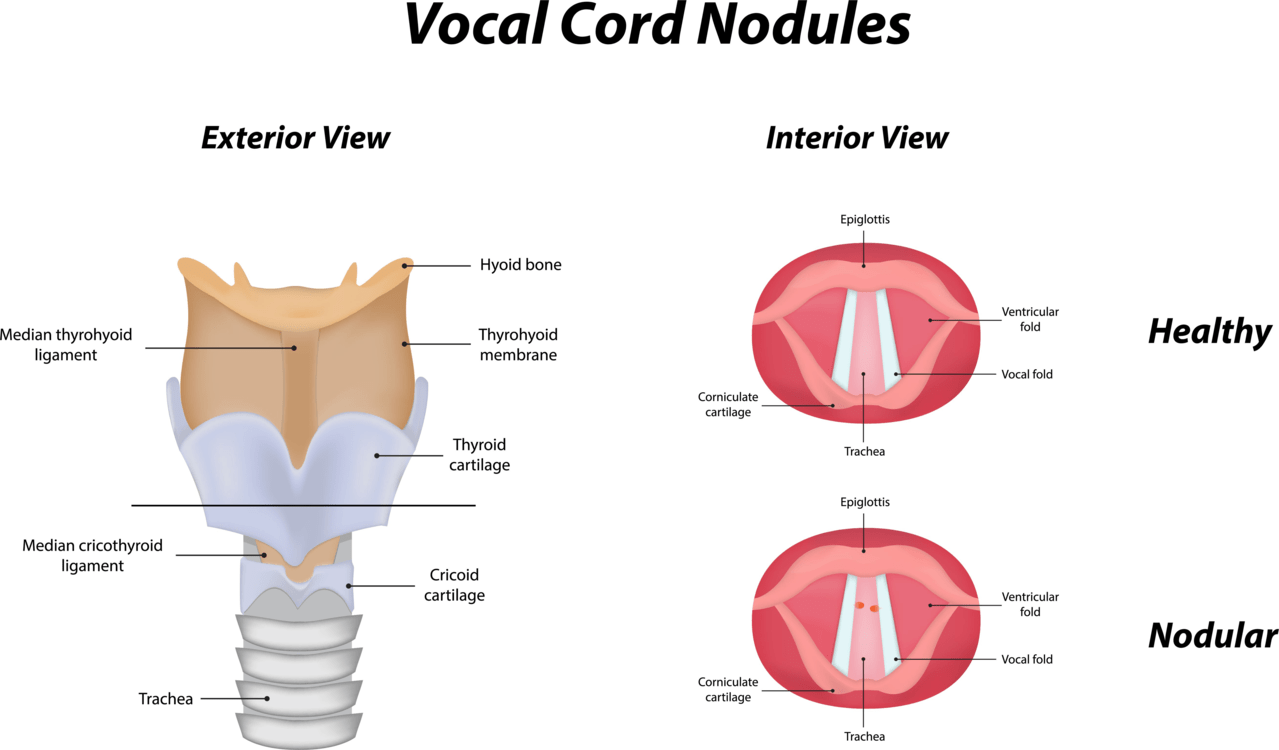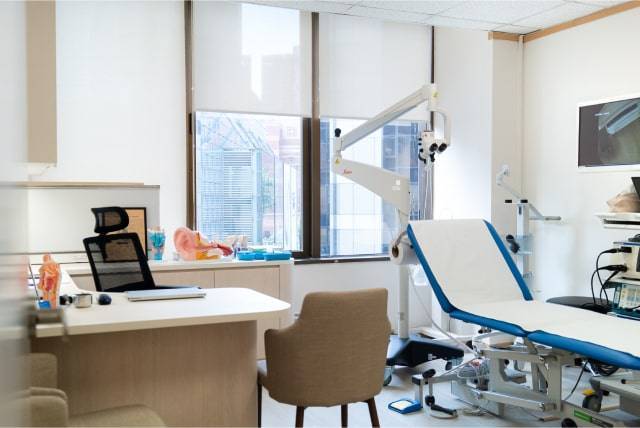
Benign vocal cord growths, also known as benign laryngeal lesions or non-cancerous voice box lesions, encompass a variety of conditions that can affect the vocal cords and impact voice quality. These growths are not malignant but can cause significant discomfort and vocal difficulties, ranging from hoarseness and vocal fatigue to complete loss of voice in severe cases. Understanding the types, causes, symptoms, diagnosis, and treatment options for benign vocal cord lesions is essential for individuals experiencing voice issues.
Types of Benign Vocal Cord Lesions
Benign vocal cord lesions come in several forms, each with unique characteristics:
- Nodules: Often called “singer’s nodes,” these are small, callous-like growths that typically appear on both vocal cords, resulting from prolonged vocal strain or misuse.
- Polyps: These are larger, softer growths that can occur on one or both vocal cords, often resulting from a single episode of vocal abuse or irritation.
- Cysts: Fluid-filled or solid lesions that form within the vocal cord tissue, potentially leading to significant voice changes.
- Reinke’s Edema: Swelling of the vocal cords due to fluid accumulation, often associated with smoking and chronic vocal misuse.
- Papillomas: Wart-like growths caused by the Human Papillomavirus (HPV), which can recur even after removal.
- Granulomas: Inflammatory lesions that typically form at the back of the vocal cords, often related to injury, intubation, or acid reflux.
Causes
The causes of benign vocal cord lesions vary depending on the type of lesion but generally include:
- Vocal Strain: Prolonged or improper use of the voice, common among singers, teachers, and other professionals who use their voice extensively.
- Vocal Abuse: Yelling, screaming, or speaking loudly and forcefully can lead to acute vocal cord damage.
- Smoking: Tobacco use can cause irritation and swelling of the vocal cords, leading to various lesions.
- Gastroesophageal Reflux Disease (GERD): Acid reflux can irritate and inflame the vocal cords.
- Infections: Viral or bacterial infections can lead to inflammation and growths on the vocal cords.
- Hormonal Changes: Shifts in hormone levels, such as those during puberty or menopause, can affect vocal cord tissue.
Symptoms
Symptoms of benign vocal cord lesions are primarily related to voice changes and may include:
- Hoarseness or Roughness: The voice may sound breathy, strained, or harsh.
- Vocal Fatigue: The voice tires easily, especially after prolonged use.
- Pitch Changes: Difficulty maintaining a steady pitch or hitting high notes.
- Voice Breaks: Sudden and unintended changes in voice pitch.
- Breathiness: Excess air escaping during speech, making the voice sound weak.
Diagnosis
Diagnosing benign vocal cord lesions involves a combination of clinical evaluation and specialized tests:
- Laryngoscopy: A visual examination of the vocal cords using a small, flexible camera inserted through the nose or mouth.
- Stroboscopy: A form of laryngoscopy that uses strobe lighting to assess vocal cord vibration and movement.
- Voice Assessment: Evaluation of voice quality, pitch, volume, and endurance.
- Imaging Studies: In some cases, MRI or CT scans may be used to assess the lesions further.
Treatment
Treatment for benign vocal cord lesions varies based on the lesion type, size, and impact on the voice:
- Voice Therapy: A speech-language pathologist can provide exercises and techniques to improve voice use and facilitate healing.
- Medical Management: Treating underlying conditions such as acid reflux or allergies can alleviate symptoms and prevent further damage.
- Surgery: In cases where lesions do not respond to conservative treatment or significantly impact voice quality, microsurgical techniques can be used to remove the growths while preserving vocal cord tissue.
- Lifestyle Changes: Hydration, smoking cessation, and avoiding vocal misuse can aid in recovery and prevent recurrence.
Prevention
Preventive measures for benign vocal cord lesions focus on healthy voice use and lifestyle choices:
- Vocal Hygiene: Regular hydration, avoiding excessive throat clearing, and maintaining overall health can support vocal health.
- Proper Voice Use: Learning and practicing good vocal techniques, especially for professional voice users, can prevent strain and injury.
- Avoiding Irritants: Refraining from smoking and exposure to pollutants can reduce the risk of vocal cord lesions.
Conclusion
Benign vocal cord lesions, while not life-threatening, can significantly affect an individual’s quality of life and professional capabilities. Early recognition of symptoms and seeking appropriate evaluation and treatment are crucial for restoring voice function. With the right combination of therapy, medical management, and lifestyle adjustments, most people with benign vocal cord lesions can achieve significant improvement in their voice and prevent future issues.
When should you see an ENT specialist in Singapore?
Please consult an ENT specialist if you are suffering from any ear, nose, or throat symptoms. It is also advisable to visit an ENT doctor if you experience persistent mouth breathing due to a chronic blocked nose or encounter snoring issues.
Dr Ker Liang sees adults and children for general ENT conditions and provides comprehensive management in a broad range of Ear, Nose, and Throat, as well as Head and Neck conditions. In particular, she has a special interest in treating throat and voice conditions, including persistent sore throat, voice issues, snoring, and Obstructive Sleep Apnoea (OSA).
Medical Teaching
Assistant Professor Ker Liang has a passion for teaching and is an Assistant Professor with NUS Yong Loo Lin School of Medicine (YLLSOM). As the NUS-NUH Otolaryngology Department Undergraduate Medical Director, Dr Ker Liang supervises the training of medical students from YLLSOM, NUS. She is actively involved
in the training of postgraduate junior doctors and residents in the Head and Neck Surgery department. She was conferred with an Undergraduate Teaching Award by the National University Health System in 2016 for her outstanding efforts as an Otolaryngology educator.
Medical Teaching
Assistant Professor Ker Liang has a passion for teaching and is an Assistant Professor with NUS Yong Loo Lin School of Medicine (YLLSOM). As the NUS-NUH Otolaryngology Department Undergraduate Medical Director, Dr Ker Liang supervises the training of medical students from YLLSOM, NUS. She is actively involved
in the training of postgraduate junior doctors and residents in the Head and Neck Surgery department. She was conferred with an Undergraduate Teaching Award by the National University Health System in 2016 for her outstanding efforts as an Otolaryngology educator.
Lorem ipsum dolor sit amet, consectetur adipiscing
Lorem ipsum dolor sit amet, consectetur adipiscing elit. Ut elit tellus, luctus nec ullamcorper mattis, pulvinar dapibus leo. Lorem ipsum dolor sit amet, consectetur adipiscing elit. Ut elit tellus, luctus nec ullamcorper mattis, pulvinar dapibus leo.
Lorem ipsum dolor sit amet, consectetur adipiscing
Lorem ipsum dolor sit amet, consectetur adipiscing elit. Ut elit tellus, luctus nec ullamcorper mattis, pulvinar dapibus leo. Lorem ipsum dolor sit amet, consectetur adipiscing elit. Ut elit tellus, luctus nec ullamcorper mattis, pulvinar dapibus leo.
Lorem ipsum dolor sit amet, consectetur adipiscing
Lorem ipsum dolor sit amet, consectetur adipiscing elit. Ut elit tellus, luctus nec ullamcorper mattis, pulvinar dapibus leo. Lorem ipsum dolor sit amet, consectetur adipiscing elit. Ut elit tellus, luctus nec ullamcorper mattis, pulvinar dapibus leo.
Lorem ipsum dolor sit amet, consectetur adipiscing
Lorem ipsum dolor sit amet, consectetur adipiscing elit. Ut elit tellus, luctus nec ullamcorper mattis, pulvinar dapibus leo. Lorem ipsum dolor sit amet, consectetur adipiscing elit. Ut elit tellus, luctus nec ullamcorper mattis, pulvinar dapibus leo.
Lorem ipsum dolor sit amet, consectetur adipiscing
Lorem ipsum dolor sit amet, consectetur adipiscing elit. Ut elit tellus, luctus nec ullamcorper mattis, pulvinar dapibus leo. Lorem ipsum dolor sit amet, consectetur adipiscing elit. Ut elit tellus, luctus nec ullamcorper mattis, pulvinar dapibus leo.



